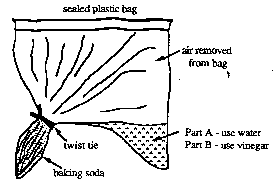 |
 |
|
|
|
|
Contributed by: New York State Education Department (NYSED) Student #2(Insert scoring rubric here)Task:At this station, you will observe two types of interactions, and then be asked to answer some questions about the interactions.
Background:
Directions:Part A
7. Set the bag aside, and continue with Part B. Part B
Questions:1. In which of the bags did a chemical change occur? Circle your answer.
2. Based on your knowledge of science and your observations, explain why you think a chemical change occurred. Give 2 reasons to support your answer.
3. Based on your knowledge of science and your observations, explain why you think a chemical change occurred. Give 2 reasons to support your answer.
Previous Student Work | Next Student Work |





